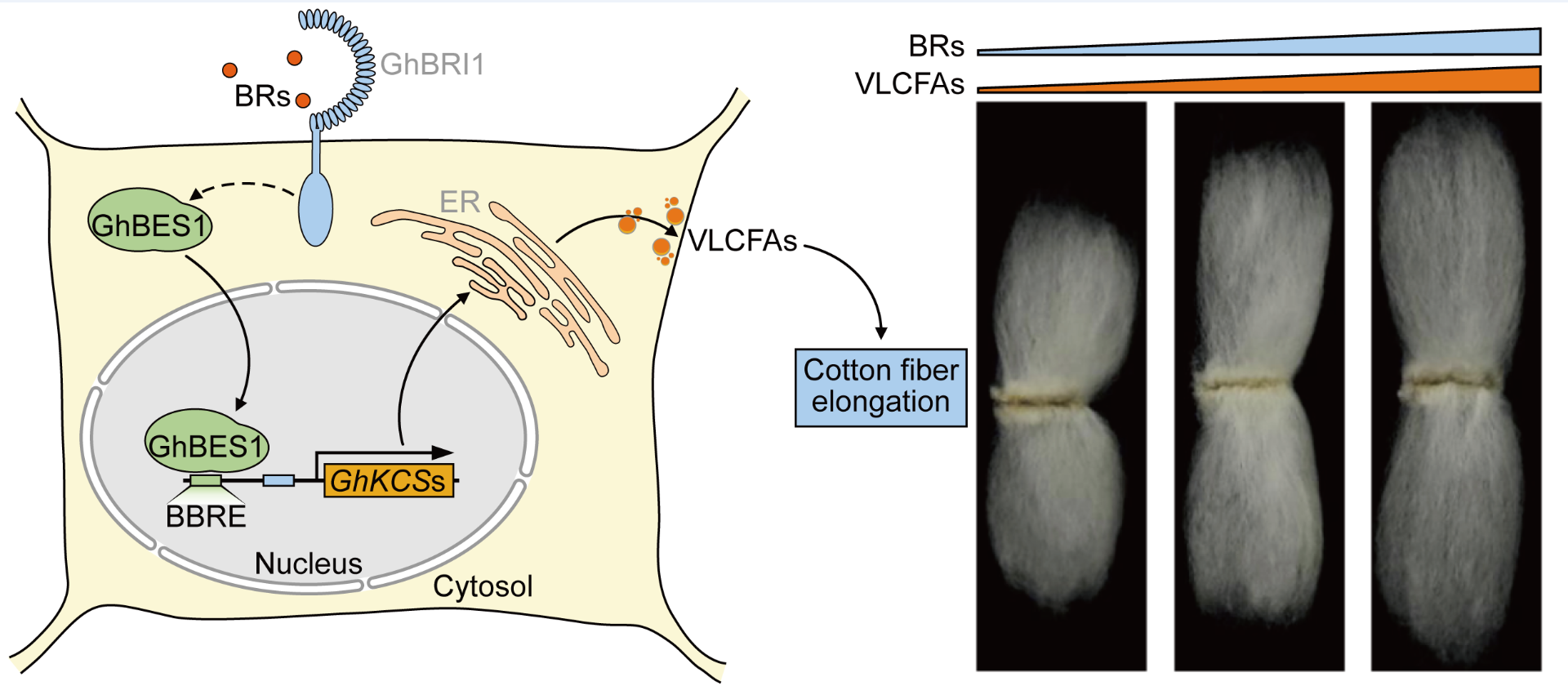- Location : Home» Newsroom
Brassinosteroids regulate cotton fiber elongation by modulating very-long-chain fatty acid biosynthesis
The research conducted by the team of Prof. Fuguang Li and Zuoren Yang from the Cotton Research Institute of the Chinese Academy of Agricultural Sciences (CRI, CAAS) revealed that cotton fiber elongation is regulated by a growth-promoting phytohormone Brassinosteroid (BR) through modulating the biosynthesis of very-long-chain fatty acids (VLCFAs). This study with the title “Brassinosteroids regulate cotton fiber elongation by modulating very-long-chain fatty acid biosynthesis” is published in “The Plant Cell”.
Cotton fiber is one of the most elongated plant cells, making it an ideal single-cell model for studying cell elongation. BRs are a group of polyhydroxylated steroidal phytohormones that are essential for plant growth and development. VLCFAs are fully saturated unbranched hydrocarbon chains (>20 carbons) synthesized in the endoplasmic reticulum and play crucial roles in plant structure, physiology, and signaling. Previous studies revealed that VLCFAs may act upstream of ethylene and promote fiber elongation in cotton. Further research has shown that BR most likely promote fiber elongation by influencing the expression of VLCFA biosynthesis, ethylene, the cell wall, and cytoskeleton-related genes. However, how relationship between BR and VLCFA contribute to fiber elongation remained uncharacterized in cotton.
In the present study, BR deficiency reduced the expression of 3-ketoacyl-CoA synthases (GhKCSs), which are rate-limiting enzymes involved in VLCFAs biosynthesis. This leads to lower saturated VLCFAs contents in pag1 mutant fibers. In vitro ovule culture experiments show that BR acts upstream of VLCFAs. Further, GhBES1.4, a master transcription factor (TF) of the BR signaling pathway, plays a key role in regulating cotton fiber elongation. Silencing of GhBES1.4 significantly reduces fiber length, whereas overexpression produces longer fibers. GhBES1.4 regulates endogenous VLCFAs contents and directly binds to BR response elements (BRREs) in the GhKCS10_At promoter region, which in turn regulates GhKCS10_At expression to increase endogenous VLCFAs contents. Furthermore, GhKCS10_At overexpression significantly promotes cotton fiber elongation, while GhKCS10_At silencing dramatically inhibits cotton fiber growth, supporting a positive regulatory role of GhKCS10_At in fiber elongation. In brief, BR regulates the biosynthesis of VLCFA mediated by GhKCSs through GhBES1, and ultimately promotes fiber elongation (Fig. 1). These findings shed new light on the intricate crosstalk between BR and VLCFAs in regulating the molecular network of cotton fiber elongation at the single-cell level with significant implications for the genetic improvement of cotton fiber quality.
This research was conducted by a group from the CRI, CAAS led by Prof. Fuguang Li (Corresponding author). Prof. Zuoren Yang, Zhao Liu (Assistant Researcher), and Xiaoyang Ge (Associate Professor) are the co-first authors of the article published on this research. This research was supported by the National Key R&D Program of China (2022YFF1001400); National Natural Science Foundation of China (No. 31971987 and 31621005); Natural Science Foundation of Henan (No. 212300410093); and Natural Science Foundation of Xinjiang Uygur Autonomous Region (No. 2022D01E08).
![]()

![]()